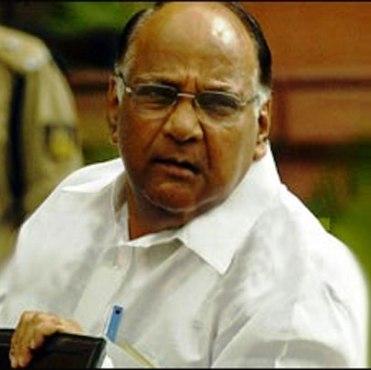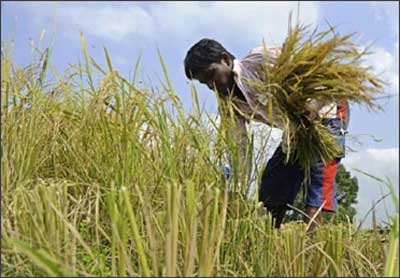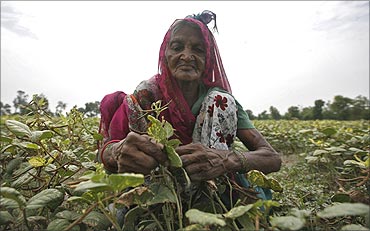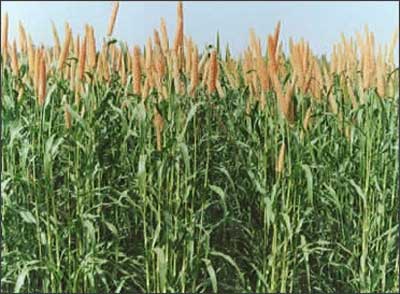India has a bumper harvest in 2010-11: Pawar
Last updated on: April 6, 2011 16:25 IST
Image: A farmer works in a mustard field.
Photographs: Reuters.
The country is estimated to have harvested a record 235.88 million tonnes (MT) of foodgrains in the 2010-11 crop year, ending June, helped by all-time high output of wheat and pulses, the government announced on Wednesday.
Economists feel that the higher foodgrain production will help further ease food inflation -- which stood at 9.5 per cent for the week ended March 19 -- in the coming weeks.
India has a bumper harvest in 2010-11: Pawar
Image: Agriculture Minister Sharad Pawar.
"The third advance estimate figures are available with me, which show an all-time record production of foodgrains at 235.88 million tonnes. Wheat at 84.27 million tonnes and pulses at 17.29 million tonnes are also the highest recorded production ever," Agriculture Minister Sharad Pawar said.
He released the third advance estimate of foodgrains production for the 2010-11 crop year (July-June) at the Kharif Conference for the next crop year.
India has a bumper harvest in 2010-11: Pawar
Image: Wheat harvest.
Photographs: Reuters.
The Agriculture Ministry has revised the estimates for foodgrains production upward to 235.88 million tonnes (MT) in the third advance estimates for 2010-11 from 232.07 MT in the second advance estimates released in February.
Thanks to the good monsoon, foodgrain production this year is nearly 18 MT higher than the 218.11 MT achieved in drought-hit 2009-10.
India has a bumper harvest in 2010-11: Pawar
Image: A farmer harvests paddy.
Photographs: Reuters.
The earlier record was 234.47 MT in 2008-09. In the foodgrains basket, the ministry has upped the production estimates for wheat, rice, pulses and coarse cereals.
"The benefit of higher foodgrains production is already showing in food inflation. The announcement of bumper crop would help further ease pressure on food prices," said D K Joshi, Principal Economist with credit rating agency Crisil. According to the third advance estimates, wheat output has risen by 3 MT from the February projection to a record 84.27 MT in 2010-11.
India has a bumper harvest in 2010-11: Pawar
Image: A women works in a pulse farm at Bakrol village on the outskirts Ahmedabad.
Photographs: Reuters.
The earlier record was 80.8 MT in 2009-10. Similarly, pulses output has been upped by nearly one million tonnes from the second advance estimate to a record 17.29 MT this year.
Last year, pulses production stood at 14.66 MT, while the all-time record of 14.91 million tonnes was achieved in 2003-04.
While rice production has been revised upward marginally to 94.11 MT in 2010-11 vis-a-vis the second advance estimate, it is much higher than the last year's output of 89.09 MT.
India has a bumper harvest in 2010-11: Pawar
Image: Coarse cereals yield rises.
Coarse cereals production, too, has been revised slightly upward to 40.21 MT in 2010-11 from the earlier estimate.
Last year's production stood at 33.55 MT. Pawar said the high level of production is expected to be achieved despite significant crop damage due to drought in Bihar, Jharkhand, Orissa and West Bengal and occurence of bad weather conditions in several other parts of the country.
India has a bumper harvest in 2010-11: Pawar
Image: Sunflower field.
Photographs: Reuters.
Oilseeds production is estimated at 30.25 MT this year, as against 24.8 MT in the previous year.
Sugarcane output is pegged at 340.55 MT in 2010-11, as against 292 MT last year.
Cotton output is estimated to have set a fresh record of 33.92 million bales (one bale is equal to 170 kg) this year, as against 24.2 million bales last year.
© Copyright 2024 PTI. All rights reserved. Republication or redistribution of PTI content, including by framing or similar means, is expressly prohibited without the prior written consent.








article